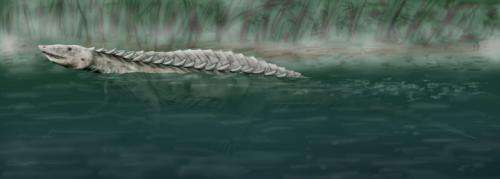March 28, 2013 report
Study shows extinction of pseudosuchians may have helped dinosaurs flourish

(Phys.org) —A pair of researchers from Germany's Ludwig-Maximilians-Universität have published a paper in the journal Biology Letters, suggesting that the mass extinction of pseudosuchians approximately 201 million years ago, helped dinosaurs thrive. Paleontologists Olja Toljagić and Richard Butler write that the one lone pseudosuchian line that survived the extinction event, likely also benefited by the demise of their cousins.
Pseudosuchians were large predators with thick body armor and big strong tales. They resembled large crocodiles and armadillos, but were not dinosaurs. They flourished during the Triassic period, but all of them save one line died out as the Jurassic period began. Scientists believe this was due to a geological event such as massive volcanic eruptions that are believed to have occurred as the Atlantic Ocean was forming—they would have spewed so much carbon dioxide into the air, that plant and animal life the world over was impacted. One of those impacts was the extinction of many animal species, including most pseudosuchians. What still puzzles researchers is why the dinosaurs flourished while so many others perished. One clue is being offered in this new research. The authors suggest that dinosaurs had better breathing biology and superior locomotive morphology, allowing them to move to where the food was. Subsequently, with fewer predators around, the dinosaurs became one of the dominate species on Earth, at least for a time.
The authors also suggest that after the die-off, the one line of Pseudosuchians that survived did very well for themselves too, radiating to many parts of the planet and eventually giving rise to all modern alligators and crocodiles. After studying many previously found specimens, the researchers have concluded that the lone survivors of the extinction event grew quite diverse in a short period of time—geologically speaking—and as a result came to inhabit swamps, rivers and even parts of some of the world's oceans.
The "sudden" death of many large predators would have had a profound impact on those that survived, the researchers note, setting back the evolutionary clock, so to speak, providing new avenues for their evolution—similar they say, to the way mammals became dominant after the extinction event that later spelled doom for the dinosaurs.
More information: Triassic–Jurassic mass extinction as trigger for the Mesozoic radiation of crocodylomorphs, Biology Letters, Published 27 March 2013 doi: 10.1098/rsbl.2013.0095 . rsbl.royalsocietypublishing.or … content/9/3/20130095
Abstract
Pseudosuchia, one of the two main clades of Archosauria (Reptilia: Diapsida), suffered a major decline in lineage diversity during the Triassic–Jurassic (TJ) mass extinction (approx. 201 Ma). Crocodylomorpha, including living crocodilians and their extinct relatives, is the only group of pseudosuchians that survived into the Jurassic. We reassess changes in pseudosuchian morphological diversity (disparity) across this time interval, using considerably larger sample sizes than in previous analyses. Our results show that metrics of pseudosuchian disparity did not change significantly across the TJ boundary, contrasting with previous work suggesting low pseudosuchian disparity in the Early Jurassic following the TJ mass extinction. However, a significant shift in morphospace occupation between Late Triassic and Early Jurassic taxa is recognized, suggesting that the TJ extinction of many pseudosuchian lineages was followed by a major and geologically rapid adaptive radiation of crocodylomorphs. This marks the onset of the spectacularly successful evolutionary history of crocodylomorphs in Jurassic and Cretaceous ecosystems.
Journal information: Biology Letters
© 2013 Phys.org

















